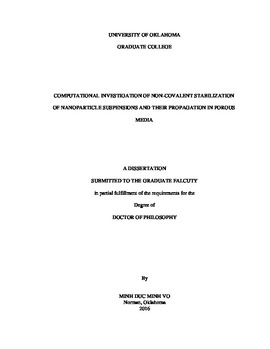| dc.description.abstract | In this study, Dissipative Particle Dynamics (DPD) and Lagrangian Particle Tracking (LPT) methods were used to investigate computationally the non-covalent stabilization of carbon nanotubes (CNT) in water by using polymers and surfactants as well as the propagation of stabilized nanoparticles (NPs) in porous media. First of all, the interaction parameters of CNT and water in DPD was validated by comparing with results from Molecular Dynamics (MD) simulations in case of the water flow past an array of single-walled carbon nanotubes (SWCNT) in different Reynolds number flows. For polymer stabilization, it was presented the conformation of PVP molecules on carbon nanoparticle (CNP) surface. Depending on the surface area and shape of NPs, there were three configurations of polymer molecules when attached on CNP surface including trains, loops and tails. The physical adsorption of PVP on CNP depended on the shear rate of the flow. There were three possible states of NPs coated with polymer under the shear. They consisted of adsorbed, shear-affected and separated states. The range of shear rate for each state was determined for CNPs with different shapes (sphere, cylinder and graphene-like). For surfactant stabilization, CNT surface changed from hydrophobic to hydrophilic in the presence of the surfactants alfoterra 123-8s (AF) and tergitol 15-s-40 (TG) surfactant adsorption. This leads to increase the solubility of CNT in water. In our simulation, it was found that AF and TG surfactant primarily formed both hemi-micelles and random adsorption on CNT surface. The assembly of surfactants on CNT relied on the interaction of the surfactant tail and the CNT surface. For surfactants in solution, most micelles had spherical shape. In the binary surfactant system, the presence of TG on the CNT surface provided a considerable hydrophilic steric effect, due to the ethylene oxide (EO) groups of TG molecules. It was also seen that the adsorption of AF was more favorable than TG on the CNT surface. Our results are applicable, in a qualitative sense, to the more general case of adsorption of surfactants on the hydrophobic surface of cylindrically-shaped nanoscale objects. Moreover, we found that sodium dodecyl sulfate (SDS) surfactant can adsorb inside surface of SWCNT if diameter of SWCNT is larger than 3 nm. When SDS was adsorbed in the hollow part of the SWCNT, the behavior of water inside the nanotube was found to be significantly changed. In addition, SDS molecules increased the retention of water beads inside SWCNT (diameter ≥ 3nm), while water diffusivity was decreased. Depending on the concentration of surfactant, SDS inside SWCNT can accumulate from 1% to 13% of the total of adsorbed surfactant. Besides, the steric effect of adsorbed PVP molecules in CNT coated PVP particle was evaluated by calculating the interaction force between particle – particle and particle – surface. The computations indicated that the repulsion of PVP polymer reduced the agglomeration of CNTs in solution and their deposition on silica surface. Finally, the propagation of nanoparticles (NPs) in porous media was also examined in both LPT and DPD simulation. It was found that drag force and random force were dominant for a single NP movement. Without the surface attraction, both spherical and cylindrical NPs can propagate through porous media. Spherical NPs underwent more collisions with the suface than cylindrical ones due to the more symmetric geometry in all directions of the sphere. For a rigid cylindrical NPs, the change of its orientation after each collision was a primary way to go around a solid surface. The distribution of orientation angle of cylindrical NPs indicated the analogous results between LPT and DPD methods. | en_US |
